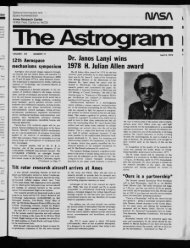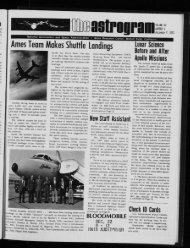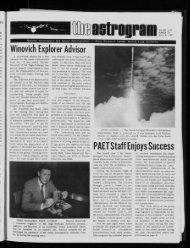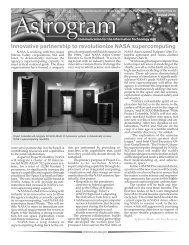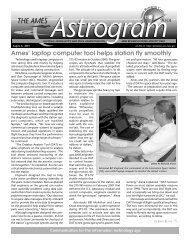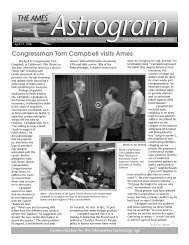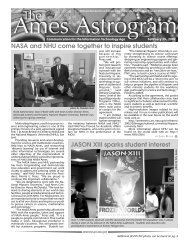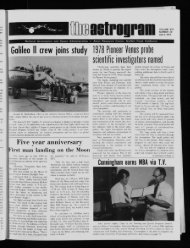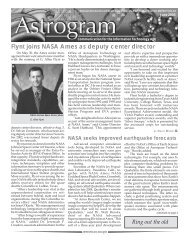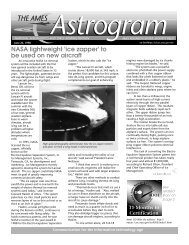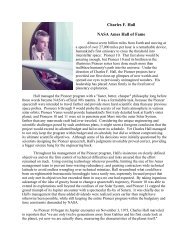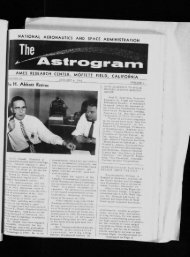Ames researchers capture aerospace spotlight/awards
Ames researchers capture aerospace spotlight/awards
Ames researchers capture aerospace spotlight/awards
You also want an ePaper? Increase the reach of your titles
YUMPU automatically turns print PDFs into web optimized ePapers that Google loves.
THE AMES<br />
June 11, 2001<br />
Astrogram<br />
NATIONAL AERONAUTICS AND SPACE ADMINISTRATION AMES RESEARCH CENTER, MOFFETT FIELD<br />
June 11, 2001 on-line at: http://amesnews.arc.nasa.gov<br />
<strong>Ames</strong> <strong>researchers</strong> <strong>capture</strong> <strong>aerospace</strong> <strong>spotlight</strong>/<strong>awards</strong><br />
Against the historic backdrop of the<br />
Smithsonian National Air and Space Museum,<br />
<strong>researchers</strong> and scientists from<br />
NASA’s “aeronautics” centers were rewarded<br />
for their hard work at the third<br />
annual Turning Goals Into Reality (TGIR),<br />
conference held in Washington DC, May<br />
16-17, 2001. <strong>Ames</strong> Research Center was<br />
again recognized as a center of groundbreaking<br />
research in the area of aero-space<br />
technology.<br />
<strong>Ames</strong> managed to improve on last year’s<br />
impressive results, winning a total of nine<br />
<strong>awards</strong> and having the lead center role in<br />
four areas.<br />
“We are pleased with the continuing<br />
success of the Center in the TGIR program,<br />
and delighted with the recognition of our<br />
accomplishments. The <strong>awards</strong> are a tribute<br />
to the techπnical capabilities and motivation<br />
of our staff,” said Skip Fletcher, Director<br />
of Aerospace.<br />
The annual TGIR <strong>awards</strong> were established<br />
in 1997 to recognize major accomplishments<br />
by NASA’s aeronautics and <strong>aerospace</strong><br />
teams and their industry and aca-<br />
<strong>Ames</strong> <strong>researchers</strong> are testing the capability<br />
of radar to detect the swirling eddies<br />
of air that trail flying aircraft. This might<br />
help unclog airports by allowing airplanes<br />
to fly closer together, according to computer<br />
scientist Karim Shariff of <strong>Ames</strong>’ NASA<br />
Advanced Super computing (NAS) division.<br />
“Engineers have been improving radar<br />
since it was invented during the World War<br />
II era, and radar can now profile the atmosphere,”<br />
said Shariff. "The idea is to detect<br />
where the vortices are so airplanes can be<br />
spaced closer as they come in for landing."<br />
Shariff spends the bulk of his time working<br />
at the <strong>Ames</strong>/Stanford Center for Turbulence<br />
(CTR). He said that the radar commonly<br />
used by the National Oceanic and<br />
Atmospheric Administration (NOAA) to look<br />
at the atmosphere may also be able to<br />
detect airplane wakes.<br />
"I did analyses of radar reflections from<br />
aircraft vortices, and the reflections are the<br />
strongest at a frequency of 50 MHz," he<br />
said. NOAA radar also operates at 50 MHz.<br />
Shariff's study is part of NASA's Aircraft<br />
Vortex Spacing System (AVOSS) research,<br />
an effort aimed at reducing airplane separa-<br />
demic partners. NASA’s<br />
Office of Aero-Space<br />
Technology (OAT) establishes<br />
goals and objectives<br />
based on the<br />
nation’s <strong>aerospace</strong> research<br />
mission, and the<br />
teams that best accomplish<br />
these goals and objectives<br />
are recognized.<br />
One of the hot topics<br />
at this year’s conference<br />
was the growing<br />
problems with airport<br />
capacity leading to flight<br />
delays, cancellations and<br />
public frustration. With<br />
air travel expected to<br />
grow and airport expansion projects meeting<br />
stiff opposition, efficient management<br />
of the nation’s airspace system is the only<br />
option. Five teams from <strong>Ames</strong> received<br />
<strong>awards</strong> for addressing this problem.<br />
The Future ATM (air traffic management)<br />
Concepts Evaluation Tool (FACET)<br />
team under <strong>Ames</strong> leadership received the<br />
CTR confronts air traffic congestion<br />
tions during approaches to landings. "One<br />
reason airports are congested is because<br />
airplanes have to be spaced far enough<br />
apart so they won't fly into the wakes of the<br />
airplane ahead," he said. Each year there<br />
are "incidents" involving larger airplanes,<br />
and other cases during which one or two<br />
light airplanes crash due to encounters<br />
with aircraft vortices, explained Shariff.<br />
"To avoid such problems, airplanes are<br />
spaced far apart," he said. “If pilots and air<br />
traffic controllers can use a radar system to<br />
detect dangerous vortices, then airplanes<br />
could fly closer together,” he stated. "If<br />
they discover dangerous vortices, the planes<br />
can fly farther apart," he said.<br />
"The next thing is do a real-world test,"<br />
said Shariff. "The U.S. Air Force has agreed<br />
to do the test at Vandenberg Air Force Base,<br />
CA." The Air Force was already planning to<br />
test radar to help correct forward-looking<br />
laser aiming devices on a 747 jumbo jet,<br />
according to Shariff. He said that he had<br />
asked Air Force officials if he could conduct<br />
his tests using the radar to look at the<br />
swirling air that trails the 747 and they<br />
photo by Jonas Dino<br />
<strong>Ames</strong>’ X-33 thermal protection team proudly displays their TGIR<br />
award at the recent Washington DC event.<br />
continued on page 7<br />
“increase capacity” award for developing<br />
air traffic management software that can<br />
evaluate air traffic patterns and determine<br />
how different conditions affect these patterns.<br />
A scenario such as severe weather<br />
over Chicago can be input into the software<br />
and it will forecast where problems<br />
will occur. With this information, controllers<br />
can route aircraft around problem areas<br />
decreasing the impact on the air traffic<br />
system.<br />
This year the Administrator’s award was<br />
presented to the Aircraft Vortex Spacing<br />
System team. The team conducted tests<br />
using radar to detect and analyze the turbulence<br />
that aircraft produce when taking<br />
off or landing. It is hoped that this new<br />
technology will permit increased airport<br />
capacity by allowing controllers to more<br />
efficiently space aircraft.<br />
The Aircraft Icing Project Team received<br />
the “revolutionize aviation” award. The<br />
team determined icing conditions, refined<br />
icing forecasting products and determined<br />
the effects of ice on aircraft performance.<br />
This work will improve aircraft de-icing<br />
procedures and increase safety in cold<br />
weather operations.<br />
Although not directly related to airport<br />
capacity, the Airframe Noise Reduction<br />
team received an award for work that will<br />
make airport operations quieter. The team<br />
conducted work identifying structural areas<br />
on aircraft that produce noise during<br />
take-off and landing. The information<br />
gained from this research will eventually<br />
continued on page 7<br />
Communication for the information technology The age <strong>Ames</strong> Astrogram — 1
Recognition & Research<br />
2001 Galileo scholarship winners announced<br />
Winners of the Galileo memorial scholarship<br />
for 2001 were announced at a banquet<br />
dinner at the Wyndham Garden Hotel<br />
in Sunnyvale on May 17. This year’s scholarship<br />
recipients are: Jesse Alejandro and<br />
Ivana Chang from San José, Gregory Donaker<br />
from Berkeley, Tammy Ma from Fremont<br />
and Saini Swati from Tracy. They are all<br />
among the top students from their respective<br />
high schools. All are accomplished<br />
athletes and musicians, and are heading to<br />
prestigious universities throughout the country<br />
to study science and engineering.<br />
Tammy Ma and Gregory Donaker each<br />
received a scholarship valued at $1,750. All<br />
other recipients were presented with $1,000<br />
<strong>awards</strong>. Each student was also given a scholarship<br />
certificate at the <strong>awards</strong> banquet.<br />
In addition to the awarding of the Galileo<br />
scholarships, world-class aerobatics champion<br />
Cecilia Aragon gave a fantastic presentation<br />
entitled, “From Fear of Flying to the<br />
World Aerobatic Championships.” During<br />
her presentation, Aragon showed some<br />
amazing video footage of her piloting skills,<br />
and encouraged everyone to take on those<br />
challenges that may initially frighten them.<br />
The Galileo memorial scholarship was<br />
established in 1973 by <strong>Ames</strong> and the San<br />
Francisco Section of<br />
the American Institute<br />
of Aeronautics<br />
and Astronautics<br />
(AIAA) to commemorate<br />
the crew who<br />
perished in the<br />
Galileo I aircraft accident<br />
on April 12,<br />
1973.<br />
The Galileo I was<br />
a Convair 990, operated<br />
by <strong>Ames</strong> as an<br />
airborne laboratory<br />
for research in aeronautics,<br />
astronautics,<br />
astronomy and Earth<br />
observations.<br />
The scholarship<br />
program is supported<br />
through donations.<br />
Residents of the Bay Area and children of<br />
<strong>Ames</strong> civil service employees, retirees and<br />
on-site contractors are eligible to apply for<br />
the scholarships. The scholarship recipients<br />
were selected from a pool of 158<br />
applicants.<br />
Administrative management of the<br />
scholarship program is provided by <strong>Ames</strong>’<br />
photo by Corwin Lakin, AIAA San Francisco Section<br />
Matt Jardin, AIAA SF chairman (far left), with 2001 Galileo memorial<br />
scholarship winners, left to right, Jesse Alejandro, Ivana Chang, Swati<br />
Saini, Tammy Ma and Gregory Donaker. Jack Boyd, executive assistant<br />
to the <strong>Ames</strong> Director, is shown far right.<br />
<strong>Ames</strong> <strong>researchers</strong> propose Mars scout projects<br />
Recently, six <strong>Ames</strong> <strong>researchers</strong> traveled<br />
to the 2001 Mars Scout mission concepts<br />
workshop in Pasadena to present their innovative<br />
ideas for 'faster, better, cheaper'<br />
ways to explore the red planet.<br />
A NASA review board is currently considering<br />
the more than 40 proposals offered<br />
by workshop participants from NASA centers,<br />
academia and industry.<br />
Mars Scout missions are a new class of<br />
focused, high-priority, experiment-based<br />
missions that can be flown for less than<br />
$300 million each. Scout missions are part<br />
of NASA's restructured Mars exploration<br />
program. The first Mars Scout mission will<br />
depart Earth as early as mid-2007. The<br />
proposed missions are based on the concept<br />
of using decentralized, competing<br />
NASA and non-NASA teams led by their<br />
principal investigators.<br />
The <strong>Ames</strong> proposals included:<br />
• Dr. Chris McKay discussed the AMEBA<br />
(Autonomous Mars Environmental and Biological<br />
Assay) concept. This project will use<br />
the already built 2001 Mars Lander. It proposes<br />
an <strong>Ames</strong>-led mission for Mars Scout<br />
to fly in 2007, with McKay serving as Principal<br />
Investigator (PI). The most innovative<br />
aspect of the proposal is a plant growth<br />
module (PGM) which will be mounted atop<br />
the lander and hold 10 varieties of a genetically-engineered<br />
mustard plant called<br />
Arabidopsous Thalania. The PGM will address<br />
key science questions about the nature<br />
of the Martian soil and the possibility of<br />
establishing future greenhouses on Mars.<br />
• Dr. Robert Haberle presented the Pascal<br />
project, a concept based on setting up a<br />
global network of 24 weather stations on<br />
Mars. Each weather<br />
station will make an<br />
hourly measurement<br />
of pressure, temperature,<br />
optical depth,<br />
and humidity for 10<br />
Mars years (more than<br />
18.8 Earth years). The<br />
most innovative aspect<br />
of the Pascal mission<br />
proposal is its<br />
unique entry probe,<br />
designed by Marc<br />
Murbach, Code SF.<br />
The probe is small,<br />
light, and self-stabilizing<br />
and could be used<br />
in future missions to<br />
deliver other payloads<br />
to Mars' surface.<br />
• Dr. Michael Sims<br />
proposed Long Day's<br />
Drive--a Rover on<br />
Mars operating during<br />
a period of sustained light.<br />
• Marc Murbach proposed Aeolus, a<br />
high-precision Scout mission concept. This<br />
mission proposes to investigate aqueous<br />
environments on Mars that are otherwise<br />
inaccessible, determine their local mineralogy<br />
and geology, and conduct soil chemistry<br />
experiments and optical imagery interpretations<br />
at each site.<br />
•Dr. Larry Lemke. together with Dr.<br />
Ronald Greeley of Arizona State (ASU),<br />
presented the Airplane for Mars Exploration<br />
(AME), with Lemke to serve as mission<br />
manager and Greeley as PI.<br />
•Dr. Butler Hine, standing in for Dr.<br />
Anita Borger of Code A. Additional scholarship<br />
review support is provided by<br />
Antoinette Price of Code D; Sidney Sun, of<br />
Code SL; Gano Chatterji, Raytheon, of Code<br />
AFC; the author in Code AFC, and members<br />
of the AIAA San Francisco Section Council.<br />
BY MATT JARDIN<br />
Image of the Autonomous Mars Environmental and Biological Assay<br />
(AMEBA), an <strong>Ames</strong>-led proposal for a Mars Scout mission in 2007.<br />
Several <strong>Ames</strong> <strong>researchers</strong> presented their innovative ideas for Mars<br />
exploration at a recent workshop in Pasadena.<br />
Steven Zornetzer, presented the proposal<br />
called Bio-Inspired Engineering of Exploration<br />
Systems (or BEES). The concept consists<br />
of micro-flyers the size of a human<br />
hand. The micro-flyers, would be launched<br />
from a Mars lander by catapult across the<br />
red planet's surface and perform aerial surveys<br />
enabling them to target and land at a<br />
particular landing site. The micro-flyers'<br />
design will enable them to use sensors and<br />
navigation techniques based on a bumblebees'<br />
flight.<br />
Six to ten of the 40 Scout proposals will<br />
be funded for further study.<br />
BY KATHLEEN BURTON<br />
2 — The <strong>Ames</strong> Astrogram June 11, 2001
Safety & VPP<br />
Magic and humor serve to teach safety lessons<br />
“Let’s see what kind of trouble we can<br />
get into today,” said magician and humorist<br />
John Drebinger opening up one of his<br />
many recent ‘Ensure Your Safety’ talks at the<br />
<strong>Ames</strong> main auditorium. An accomplished<br />
entertainer, Drebinger is renowned for his<br />
offbeat safety presentations to employees<br />
of some of America’s biggest business organizations.<br />
He was invited by the Center’s<br />
Voluntary Protection Program (VPP) planning<br />
team to “keep safety the focus of our<br />
attention” in the words of Center Director<br />
Dr. Henry McDonald.<br />
“Come on up here,” he coaxed Karen<br />
Gentry of <strong>Ames</strong>’ Financial Management<br />
Division. “Be careful coming up the steps;<br />
tripping wouldn’t be good at a safety talk,”<br />
he joked.<br />
“What’s this?” he asked as he performed<br />
sleight of hand tricks for the audience with<br />
a small fuzzy red ball using Gentry as his<br />
accomplice. “Supposedly, he put one ball<br />
in my hand, but when he opened it, there<br />
were two,” Gentry later related.<br />
“Before you go, I have a present. How<br />
would you like this watch?” Drebinger asked,<br />
returning to Gentry her very own timepiece.<br />
“He grabbed my hand when I first<br />
went up there, and that’s when he must<br />
have taken my watch,” she said. “I didn’t<br />
notice it was gone until he lifted it out of his<br />
pocket. He’s a very crafty fellow,” she added.<br />
His humorous approach and magic tricks<br />
certainly seemed to relax and warm-up his<br />
audience.<br />
“What’s this safety stuff all about?” he<br />
asked, easing into the reason for his talk. “I<br />
work in an office or a lab and I know what<br />
I’m doing,” he said, verbalizing what many<br />
in the audience were probably thinking.<br />
“Nothing bad can happen to me. Why<br />
should I work safely?” he mused. Then he<br />
showed pictures of his family in his wallet.<br />
Everyone should be safe for their family’s<br />
sake, or simply to enjoy activities like pleasure<br />
boating, he said. “If that boat’s the<br />
reason why somebody works safely, well<br />
that’s okay, too,” he added.<br />
“Think in terms of why you want to work<br />
safely,” he said. “There is NO place that is<br />
safe. Everybody who came in here today<br />
came up stairs. Did you use fall protection?”<br />
he asked. Even handrails are safety devices,<br />
he explained. Always using handrails on<br />
steps is safer, he pointed out. “Don’t just<br />
grab for a handrail as you slip, because you<br />
can hurt your back.”<br />
“You folks have a lot of steps here, and<br />
if you use the rail, you have less chance of<br />
being hurt. You need to take personal responsibility<br />
for your safety,” he stated. After<br />
June 11, 2001<br />
the talk, most people were observed using<br />
the handrails as they descended the auditorium<br />
steps.<br />
Even walking<br />
through the doors<br />
of a warehouse store<br />
to shop can be unsafe,<br />
said Drebinger.<br />
He told the story of<br />
an employee at the<br />
Johnson Space Center<br />
who inadvertently<br />
deflected a<br />
drill press that fell<br />
on him at a warehouse<br />
store. He was<br />
injured and was removed<br />
from flight<br />
status, according to<br />
Drebinger. He<br />
added that, person-<br />
ally, he would never<br />
take children into<br />
warehouse locations.<br />
“You work together,<br />
so you don’t want to see colleagues<br />
hurt,” he said. “And, it is possible to predict<br />
the future,” he asserted. “I’ll give you an<br />
example.” He then told a story about observing<br />
a driver make an unsafe left turn. He<br />
bet his child that in a short time they would<br />
see the driver make another unsafe move<br />
and, sure enough, they did. He related a<br />
second automobile story. “I saw a dentedup<br />
car, and unconsciously put my foot<br />
above the brake. When they cut in front of<br />
me, I hit the brake, and avoided a collision,”<br />
he said. “Safety is also about ‘What if something<br />
happens? What will I do?’” he said.<br />
“I’ve done some illusions — tricks for<br />
you. We take a short cut, and it works — I<br />
can eat a hamburger, brush my teeth and<br />
be on the cell phone all at the same time.<br />
This teaches our brains that it’s safe to do<br />
unsafe acts. But it’s an illusion,” Drebinger<br />
said. Not only lazy people take short cuts,<br />
he offered, everyone does to save time and<br />
money. “The pressure is on to do it quicker,”<br />
he said. “You take a shortcut, and you teach<br />
someone else to do it too. It’s a kind of<br />
unconscious learning that takes place. If<br />
you’re really good at something, you must<br />
still do it the right way so that you teach<br />
them the right way to do it,” he added.<br />
“The greater majority of injuries don’t<br />
kill people, but they affect them for the rest<br />
of their lives,” he said. “I’m going to show<br />
you how a magician tears a newspaper up<br />
and puts it back together again. The newspaper<br />
is like you. You can rip it up and tape<br />
it. The newspaper is taped, but it’s not as<br />
good as it was before. After an injury, you<br />
photo by Tom Trower<br />
Karen Gentry of <strong>Ames</strong>’ Financial Management Division (left) assists John<br />
Drebinger (right) with a magic trick. Drebinger is a magician and humorist,<br />
who gave a series of talks at <strong>Ames</strong> on safety.<br />
are more likely to be injured again,” he said.<br />
He tore a newspaper, appeared to unfold it,<br />
and it was not ripped.<br />
Personal protective equipment affords a<br />
safety margin if something goes wrong,<br />
Drebinger said, transitioning into another<br />
safety subject. “We should always use<br />
seatbelts. Seatbelts apply to everybody.<br />
Anybody ever needed one?” he asked the<br />
audience. “You?” he said to a man who<br />
raised his hand. “What happened?” “I rolled<br />
my car,” the man said.<br />
“I only needed a seatbelt once,” said<br />
Drebinger. He said he was driving on a<br />
country road and slowed to 35 mph when<br />
he saw a truck stopped ahead at an intersection.<br />
“The driver looked both ways, but<br />
he still hit me and dragged my car 150 feet.<br />
I wouldn’t be here to make this show today<br />
if I hadn’t been wearing that seatbelt,”<br />
Drebinger said. “A policeman at the accident<br />
site told me, ‘it happens a lot.’ Some<br />
of you are walking around your work facility<br />
and thinking of something else, galaxies,<br />
maybe, and not paying attention, he continued.<br />
Not actually seeing what you are<br />
looking at — cognitive failures, such as this<br />
— are very common,” he said. “They looked,<br />
but they didn’t see.”<br />
In many cases, victims can do something<br />
to lessen their injury, Drebinger asserted.<br />
“Even when other people mess up,<br />
I can do something to protect myself,” he<br />
said. “It’s what you do that makes the<br />
continued on back page<br />
The <strong>Ames</strong> Astrogram — 3
Summer Scholars & Special Visitors<br />
Minority University Research and Education<br />
Program (MUREP) students arrive at <strong>Ames</strong><br />
WWII bomber pilot visits <strong>Ames</strong><br />
MUREP NASA Scholar students are shown here on their<br />
orientation day. The students will be involved in various<br />
engineering and research projects during their ten-week<br />
internship at <strong>Ames</strong>. The program began May 29 and ends<br />
August 3. This year, <strong>Ames</strong> is pleased to host 33 Interns from<br />
various states across the country and Puerto Rico. The NASA<br />
Scholars Summer Internship Program is part of the MUREP<br />
program within the Equal Opportunity Programs Office, Code<br />
DE. Program Manager Brenda Collins and MUREP team<br />
members Mary Bravo and Marissa Travers have an exciting<br />
program planned for the Interns this year, so look forward to<br />
follow-on articles throughout the summer.<br />
photo by Eric James<br />
On May 18, a Channel 7, KGO TV news helicopter arrived at NASA Base<br />
Operations, Building 158, to pick up reporter Wayne Freedman; cameraman<br />
Doug Laughlin and Walter and Violet Hughs to transport them to Stockton.<br />
Hughs, a bomber pilot during WWII, boarded a WWII bomber in Stockton and<br />
arrived back at Moffett in the early afternoon. Freedman interviewed Hughs<br />
inflight from Stockton to <strong>Ames</strong> and then again on the ground at Base Operations<br />
for an upcoming TV news special segment.<br />
Walter Hughs, (right), World War II veteran and subject of a Channel 7<br />
special report, arrives at NASA Base Operations at Moffett Field.<br />
photos by Tom Trower<br />
4 — The <strong>Ames</strong> Astrogram June 11, 2001
Sally Ride visits<br />
Space Camp<br />
Former astronaut Sally Ride, the first<br />
American woman to fly in space, shown<br />
during a recent visit to U.S. Space Camp,<br />
California.<br />
Horace Emerson<br />
passes away<br />
Horace F. Emerson passed away in Portland,<br />
Oregon on April 8. He was 82. Emerson<br />
was born in Grass Valley, CA in 1919 and<br />
was a long-time Sunnyvale resident, moving<br />
to Reno, NV in 1975.<br />
Horace Emerson<br />
Emerson was a decorated veteran of<br />
World War II, European Theater, 89th Infantry<br />
division and also a mason for 50 years.<br />
He was a graduate of the Stanford School<br />
of Engineering in 1947. Emerson was employed<br />
for 27 years with NACA and NASA<br />
<strong>Ames</strong> (1947-1974) working in the 12-foot<br />
and 14-foot wind tunnels. He retired as<br />
director of the <strong>Ames</strong> Office of Technology<br />
Utilization in 1974.<br />
Emerson is survived by his wife of 59<br />
years, Donna, and children Jim and Judy;<br />
daughter-in-law, Shelley; granddaughters<br />
Hearther, Hillary and Dana and great-granddaughter<br />
Rowen. The family recommends<br />
donations to the Stanford Band.<br />
June 11, 2001<br />
photo by Valerie Bunnell<br />
Outreach & the Community<br />
Volunteers promote ‘tech’ awareness<br />
Volunteers from <strong>Ames</strong> and throughout<br />
the Bay Area are strong supporters of<br />
Oakland’s annual Math, Science and Technology<br />
Awareness Fair. This year was no<br />
exception!<br />
Volunteers at the May 22-23 Oakland Math, Science and Technology<br />
Awareness Fair show mineral samples to young attendees.<br />
On May 22-23, more than 60 enthusiastic<br />
volunteers descended upon the Henry<br />
J. Kaiser Convention Center for this year’s<br />
event. The estimated 3,000 attendees<br />
were treated to exhibits offered by 20<br />
different groups.<br />
The Fair has been in existence for 10<br />
years and originated as a place where minority<br />
students, kindergarten through<br />
eighth grade, can meet and interact with<br />
engineers and employees in science, high<br />
tech, business, education and government.<br />
For many of these students, it is the first<br />
time they are able to see such an array of<br />
ideas and concepts. The students are bused<br />
to the Fair from East Bay schools throughout<br />
Alameda and Contra Costa Counties.<br />
Each year, the Society for Mining, Metallurgy<br />
and Exploration (SME), San Francisco<br />
Section’s, Government, Education and<br />
Mining (GEM) Committee provides educational<br />
outreach through an exhibit about<br />
minerals and mining, according to Joe<br />
Hanzel, facilities safety manager for the<br />
Astrobiology and Space Research Directorate<br />
and an SME member. This was the<br />
fourth year for the SME-GEM exhibit, one<br />
of the most popular at the Fair, according<br />
to organizers, including the African Scientific<br />
Institute and the Oakland Unified School<br />
District.<br />
Students and teachers alike agree about<br />
the neat things to see at the exhibit. The<br />
students are treated to hands-on examination<br />
of mineral specimens (ore) and can<br />
relate to it’s relevance in their life by looking<br />
at finished products on display that are<br />
common in their schools and homes. Hand<br />
loupes for viewing the minerals are demonstrated<br />
by the volunteers and provided to<br />
the students for a personal close look at<br />
some of the wonders of the Earth’s resources.<br />
There are hands-on quizzes about<br />
coal, pumice, iron, bauxite and the recycling<br />
of aluminum. There are over 20<br />
minerals on display and related finished<br />
products. The volunteers ask questions of<br />
the visitors to find out about their knowledge<br />
and perceptions of the Earth.<br />
This year’s volunteers pool represented<br />
many professions and came from companies<br />
in the Bay Area representing mining,<br />
engineering, construction, science, environment<br />
and government. In particular,<br />
the GEM Committee is especially grateful<br />
to this year’s <strong>Ames</strong> participants. They included<br />
Bruce Borchers, Orbital Sciences<br />
Corporation; Lynda Nicholson, Professional<br />
Analysis, Inc.; Alissa Morelan, Ivan Vines<br />
and Stepharn C.J. Gracia, Johnson Controls,<br />
Inc.; Michelle Lane, Harold Francis,<br />
Mark Moran, Omar Talavera and Rob Merlo,<br />
Lockheed Martin Engineering & Sciences<br />
Company; and George Cooper and Joe<br />
Hanzel from NASA.<br />
For more information about the annual<br />
minerals exhibit at the Fair, contact Joe<br />
Hanzel at ext. 4-0265 or via e-mail at:<br />
jhanzel@mail.arc.nasa.gov<br />
The <strong>Ames</strong> Astrogram — 5
Events & Visits<br />
Free flights, plane pull, classic cars featured at <strong>Ames</strong><br />
A full day of activities, including free<br />
flights aboard a variety of privately owned<br />
aircraft, an opportunity to pull a 150,000<br />
pound jet aircraft 12 feet in the fastest time<br />
and a classic car display will be featured at<br />
Moffett on Saturday, June 16.<br />
Sponsored by the Santa Clara County<br />
Law Enforcement Torch Run, the third an-<br />
nual "Airplane Pull" will begin with registration<br />
at 8 a.m. Approximately 4,000 participants<br />
and spectators are expected to attend<br />
the Airplane Pull, which benefits the<br />
Special Olympics in Santa Clara County.<br />
Last year, more than $20,000 was raised<br />
from the one-day event. Plane Pull teams<br />
consist of 23 members competing against<br />
each other to pull a United Airlines Boeing<br />
727 a set distance in the shortest amount of<br />
time. Gates will open at 7:30 a.m. The<br />
competition will begin at 9 a.m. and continue<br />
until 2 p.m.<br />
Starting at 10 a.m, the Experimental<br />
Aircraft Association (EAA) Aviation<br />
Foundation's Young Eagles will offer free<br />
flights over Moffett Field for youths ages 8<br />
to 17. The event is designed to educate<br />
Brown University professor<br />
speaks at <strong>Ames</strong><br />
On May 24, Dr. Annette Coleman, professor of natural history at<br />
Brown University, delivered a lecture at <strong>Ames</strong> entitled "Selection from<br />
first principles: why all life forms will speciate." Her thesis is that since<br />
the universe is not stable, all living creatures will always be comprised<br />
of subgroups which are selected for successful genetic exchange.<br />
Two young eagles, Erin and Kelly O'Neill of Santa Clara, flew in a Cessna 177 (Cardinal) aircraft<br />
at Moffett during last year's International Young Eagles Day.<br />
young people about airplanes and help<br />
them discover career opportunities in aviation.<br />
EAA pilots volunteer their time to<br />
support this activity and bring with them 35<br />
aircraft for the youths to ride in. The flights,<br />
which are designed to provide a motivational<br />
aviation experience for the youths,<br />
will continue until 3 p.m.<br />
"The Young<br />
Eagles program is<br />
photo by Tom Trower<br />
trying to reach out<br />
to children who<br />
want to spread<br />
their wings and<br />
conquer the sky.<br />
This event will provide<br />
Bay Area kids<br />
with a unique opportunity<br />
to fly on<br />
small and mediumsized<br />
airplanes<br />
side-by-side with<br />
real pilots," said<br />
Young Eagles program<br />
coordinator<br />
Ron Palermo. "The<br />
local EAA Chapter<br />
is excited about the<br />
opportunity to<br />
hold this Young<br />
Eagle's event at an<br />
historic place like<br />
<strong>Ames</strong>, so well<br />
known for its aviation<br />
research and<br />
strong community<br />
ties."<br />
Also featured during the day will be a<br />
display of approximately 100 classic cars<br />
representing several local car clubs, demonstrations<br />
and displays of law enforcement<br />
equipment, musical entertainment<br />
and refreshments.<br />
Admission is free to all events. No pets<br />
will be allowed. Visitors are urged to enter<br />
Moffett via the Ellis Street gate and proceed<br />
to Hangar 1, where free parking will be<br />
available.<br />
Further information about the Young<br />
Eagles is available at www.eaa62.org. Details<br />
about the Plane Pull can be obtained by<br />
calling Tiffany Lloyd Lofton or Sgt. Danny<br />
Acosta at (408) 267-2734.<br />
BY MICHAEL MEWHINNEY<br />
Contractors<br />
respond to<br />
challenge<br />
Congratulations to all <strong>Ames</strong> contractors.<br />
Your response to Mr. Goldin's<br />
challenge has set a record here at <strong>Ames</strong>.<br />
The contractors have currently completed<br />
over 125 days or 1,000,000<br />
work hours with no lost-time injuries.<br />
We look forward to maintaining a safe<br />
workplace and watching this record<br />
grow.<br />
6 — The <strong>Ames</strong> Astrogram June 11, 2001
Senior SAIC scientist visits <strong>Ames</strong><br />
June 11, 2001<br />
photo by Dominic Hart<br />
<strong>Ames</strong> <strong>capture</strong>s TGIR <strong>spotlight</strong><br />
continued from front page<br />
lead to quieter aircraft designs, thereby<br />
decreasing the disturbance to communities<br />
surrounding airports.<br />
The International Space Station has highlighted<br />
the need for a safer and more affordable<br />
transportation to and from low Earth<br />
orbit. Two <strong>Ames</strong>-led teams are speeding to<br />
accomplish this goal. The Highly Maneuverable<br />
Crew Transfer Vehicle Development<br />
team has designed a reusable vehicle concept<br />
that uses ultra-high temperature ceramics<br />
on the leading edges. This allows<br />
more controlled descent from space and<br />
increased maneuverability in the atmosphere.<br />
The X-33 Thermal Protection Systems<br />
Development team received the “mission<br />
affordability” award for the development<br />
and integration of thermal protection<br />
materials on a fully reusable launch vehicle.<br />
These systems will be critical to the development<br />
of the next-generation reusable launch<br />
vehicle under the Space Launch Initiative. A<br />
fully reusable vehicle will significantly reduce<br />
the costs of sending cargo and personnel<br />
to the space station.<br />
This year, two design tools received<br />
<strong>awards</strong>. The Control Designer’s Unified<br />
Interface (CONDUIT) Design team received<br />
the “engineering innovation” award. Developed<br />
at <strong>Ames</strong>, CONDUIT allows for the<br />
rapid modeling and analysis of flight-control<br />
systems for new aircraft. The system<br />
uses a graphical user interface to determine<br />
the benefits and weaknesses of different<br />
design specification. This tool has reduced<br />
the cost and development time for flight<br />
control interfaces in numerous manned and<br />
unmanned aircraft. The Numerical Propulsion<br />
System team received the “pioneering<br />
technology innovation” award for developing<br />
software that is able to completely<br />
model a propulsion system. The software<br />
will permit the testing of new designs and<br />
Research & Compliance<br />
Dr. Greg Gmurczyk,<br />
senior scientist at<br />
Science Applications<br />
International<br />
Corporation (SAIC) for<br />
the NASA Office of<br />
Space Science, right,<br />
visited <strong>Ames</strong> on May<br />
23. Here he is shown<br />
in discussion with the<br />
Information Science<br />
and Technology’s<br />
Directorate’s Tony<br />
Gross.<br />
modifications, reducing development and<br />
testing costs.<br />
A new goal this year from OAT was to<br />
develop commercial applications for NASA<br />
technology. The Broadband SatCom/Ring<br />
Buffer Network team was awarded the<br />
“commercialize technology” award for accomplishing<br />
this task. The team developed<br />
technology to increase satellite-based transmission<br />
of data creating a broadband solution<br />
for areas not served by land-based<br />
systems.<br />
The 2001 TGIR conference provided<br />
two days of thought-provoking presentations<br />
and candid panel discussions on the<br />
future of aviation and space travel. NASA’s<br />
technology leadership role, commercial<br />
applications of NASA-developed technologies<br />
and the energizing of industry and<br />
academic partnerships were among the<br />
topics discussed in the numerous conference<br />
workshops. The annual conference<br />
gives leading experts in the field a chance<br />
to step back, debate and collaborate on the<br />
future of aeronautics and <strong>aerospace</strong>.<br />
The next TGIR conference is planned for<br />
May 21-22, 2002 at <strong>Ames</strong>.<br />
BY JONAS DINO<br />
Hoy passes away<br />
Herb Hoy died on May 13, 2001, as a<br />
result of a heart attack.<br />
Hoy was born in Seattle, where he received<br />
degrees in both mathematics and<br />
aeronautical engineering from the University<br />
of Washington. He worked the past 30<br />
years as a computer engineer here at <strong>Ames</strong><br />
and more recently at Dryden.<br />
Hoy was an avid golfer and an active<br />
member of the <strong>Ames</strong> Golf Club. He will be<br />
missed by his many friends and co-workers.<br />
Services were held May 19.<br />
Federal agencies<br />
ordered to<br />
upgrade new<br />
web sites<br />
Recent federal law has mandated that<br />
all federal agencies undertake an effort to<br />
upgrade new web sites to be compliant<br />
with new national standards.<br />
Section 508 of the Rehabilitation Act of<br />
1973, was amended on December 21, 2000.<br />
This law requires federal agencies to make<br />
all new electronic and information technology<br />
developed, procured, maintained, or<br />
used by the agencies accessible to federal<br />
employees and members of the public with<br />
disabilities. Center exposure to liability for<br />
complaints of non-compliance begins June<br />
21, 2001.<br />
Accordingly, all new web sites launched<br />
or modified after June 21, 2001 must meet<br />
this criteria. The relevant 16 standards can<br />
be found at: http://www.webaim.org/<br />
standards/508/checklist.<br />
The web services group is offering a<br />
Section 508 11th hour web users group<br />
(WUG) seminar to assist in making the<br />
required changes to <strong>Ames</strong> sites.<br />
This presentation covers information<br />
ranging from high-level policy to implementation<br />
details and HTML tags. Technical<br />
staff will be available to answer any<br />
questions about Section 508. The presentation<br />
will be held June 20 at 11 a.m. to<br />
12:30 p.m. in the bldg. N-258 auditorium.<br />
Send topics you wish to have addressed to<br />
Felicia Multz at e-mail:<br />
fmultz@mail.arc.nasa.gov The contact<br />
person is Elizabeth Tu at e-mail:<br />
etu@mail.arc.nasa.gov or ext. 4-6348. Web<br />
sites URLs are: http://wug.arc.nasa.gov and<br />
http://webmaster.arc.nasa.gov/access<br />
CTR confronts<br />
air traffic<br />
congestion<br />
continued from front page<br />
consented. He said the Air Force does not<br />
plan to charge NASA for the tests.<br />
"The costs so far have just been my own<br />
pencil-and-paper work," said Shariff. He<br />
explained that the tests should be done in<br />
a real-world situation because of the many<br />
variables that can affect aircraft vortices,<br />
including crosswinds, atmospheric turbulence<br />
and other factors.<br />
There are special features that have to<br />
be developed before the NOAA radar could<br />
be used for tracking vortices. "Synthetic<br />
aperture radar, which combines data<br />
streams from a moving radar, might be a<br />
possibility for development of an airborne<br />
vortex tracker," he said.<br />
BY JOHN BLUCK<br />
The <strong>Ames</strong> Astrogram — 7
<strong>Ames</strong> manager<br />
receives<br />
prestigious<br />
award<br />
George Sarver, project manager for the<br />
Space Station Biological Research Project<br />
(SSBRP), was presented with an agency<br />
Quality and Safety Achievement Recognition<br />
(QASAR) award for 2000. Dan Goldin<br />
recently presented the award at a continuous<br />
improvement conference in Washington<br />
D.C. In January, Sarver was nominated<br />
for and received the <strong>Ames</strong> award, which<br />
carries a nomination for the Agency award.<br />
He was then selected among nominees<br />
from every NASA center to receive the<br />
Agency award.<br />
Sarver’s job duties include a comprehensive<br />
safety and mission assurance effort.<br />
He has provided outstanding management<br />
support to ensure that safety, mission assurance<br />
and other requirements are effectively<br />
integrated into many highly complex systems<br />
by both U.S. developers and international<br />
partners.<br />
Sarver had the foresight to develop the<br />
first risk management plan for SSBRP. This<br />
plan includes a framework for using safety<br />
priorities in risk decision-making. He has<br />
played a crucial role in developing quantitative<br />
reliability goals for the various SSBRP<br />
payloads, as well as defining the microgravity<br />
payload fire protection design requirements<br />
for the payloads. Both of these<br />
efforts are serving to reduce negative system<br />
performance impacts while meeting<br />
safety and performance requirements and<br />
increasing the likelihood of mission success.<br />
QASAR <strong>awards</strong> are presented locally at<br />
<strong>Ames</strong> and agency-wide to individuals who<br />
contribute to significant advances in safety<br />
and quality programs in a variety of capacities.<br />
Awards are presented in four categories:<br />
safety and mission assurance personnel,<br />
NASA employees outside of safety and<br />
mission assurance, non-NASA government<br />
employees in NASA support roles, and contractors<br />
and subcontractors making significant<br />
safety and quality related contributions.<br />
Please consider your co-workers or<br />
other deserving <strong>Ames</strong> personnel as nominees<br />
for future QASAR <strong>awards</strong>.<br />
BY DOUG SMITH<br />
Safety & Awards<br />
SAFETY<br />
SAFETY<br />
SNAPSHOTS<br />
SNAPSHOTS<br />
George L. Sarver III<br />
shown here in his office,<br />
is the recipient of the<br />
2000 QASAR award for<br />
outstanding leadership in<br />
the field of safety and<br />
safety awareness.<br />
photo by Tom Trower<br />
This feature is one in a series intended to inform the <strong>Ames</strong> community about facets of <strong>Ames</strong>’<br />
safety and health programs.<br />
Health Unit<br />
PROFILE<br />
When you are at work at <strong>Ames</strong>, where do you go if you feel sick or hurt yourself? Where do<br />
you go if you need laser safety glasses, travel immunizations or consultation about the health<br />
effects of a workplace chemical? <strong>Ames</strong>’ Health Unit is a busy multi-functional health care<br />
center meeting routine occupational medical needs of <strong>Ames</strong> employees, while also maintaining<br />
readiness to respond to emergencies involving life and health.<br />
CLOSEUP<br />
Dr. Meyers, medical director, says that over 6,500 employee visits each year keep the Health<br />
Unit’s staff busy. The Health Unit and Fitness Center together provide services in five main<br />
areas, including medical care, health maintenance, medical surveillance, wellness and fitness.<br />
The Health Unit’s main purpose is to provide medical care and emergency services to all civil<br />
servants, contractor employees and visitors. About 20% of visits to the Health Unit are for<br />
treatment and advice to address illnesses and injuries. It is very important that everyone report<br />
to the Health Unit as soon as they are injured or feel ill. Prompt and appropriate medical care<br />
can make a positive difference in treatment and recovery time.<br />
Preventative maintenance is another main focus of the Health Unit and Fitness Center. The<br />
Health Unit provides occupational medical examinations, such as spirometry (lung capacity)<br />
tests for respirator users and audiometry (hearing tests) for employees who work in high-noise<br />
areas. The purpose is to ensure that employees are able to perform their tasks without<br />
detrimental health effects.<br />
The Fitness Center provides over 30 fitness classes per week, individual evaluations, fitness<br />
programs, special fitness events, a training wall for rock climbing and state-of-the-art exercise<br />
equipment. The Fitness Center is designed to help <strong>Ames</strong> employees obtain their highest level<br />
of wellness. For more information, see the website: http://fitnesscenter/<br />
More of us will stay healthy throughout this year’s flu season as a result of the over 1,500 flu<br />
shots provided to government employees and contractors. The Health Unit also provides<br />
health maintenance to civil servants in the form of periodic health assessments, the frequency<br />
of which are determined by the employees’ age. The Health Unit also plays a key role in the<br />
Employee Assistance Program (EAP) to provide civil servants and their dependents with shortterm,<br />
confidential counseling and referral, as necessary.<br />
For more information about <strong>Ames</strong> Health Unit, go to <strong>Ames</strong> Health and Safety Manual, AHB<br />
1700.1, Chapter 3 which can be found on the Code Q website at: http://Q/ or stop by the<br />
Health Unit and pick up some of the many health-related brochures on display.<br />
8 — The <strong>Ames</strong> Astrogram June 11, 2001
<strong>Ames</strong> Classifieds<br />
Ads for the next issue should be sent to<br />
astrogram@mail.arc.nasa.gov by the Monday following<br />
publication of the present issue and must be resubmitted<br />
for each issue. Ads must involve personal needs or<br />
items; (no commercial/third-party ads) and will run on<br />
space-available basis only. First-time ads are given<br />
priority. Ads must include home phone numbers; <strong>Ames</strong><br />
extensions and email addresses will be accepted for<br />
carpool and lost & found ads only. Due to the volume<br />
of material received, we are unable to verify the accuracy<br />
of the statements made in the ads.<br />
Housing<br />
Event Calendar<br />
Model HO/HOn3 Railroad Train Club at Moffett<br />
Field invites train buffs to visit & join the club in Bldg. 126,<br />
across from the south end of Hangar One. Work nights are<br />
usually on Friday nights from 7:30 p.m. to 9:30 p.m. Play<br />
time is Sunday from 2 p.m. to 4 p.m. For more info, call<br />
John Donovan (408) 735-4954 (W) or (408) 281-2899 (H).<br />
Jetstream Toastmasters, Mondays, 12 noon to 1<br />
p.m., N-269/Rm. 179. Guests welcome. POC: Samson<br />
Cheung at ext. 4-2875 or Lich Tran at ext. 4-5997.<br />
<strong>Ames</strong> Ballroom Dance Club, Tuesdays: East Coast<br />
Swing and Jive 6/12, 6/19, Paso Doble 6/26. 3 levels of<br />
classes, from Beg. to Int., 5:15 - 6:45pm. Classes in<br />
Building 944, the Recreation Center. Women dancers<br />
encouraged to join. POC: Helen Hwang,<br />
hwang@dm1.arc.nasa.gov.<br />
3 bd/1.5 ba, 2-story twnhs on Luz Avenue, San José.<br />
Freshly painted inside, dishwasher, gas heat, w/w carpet,<br />
outside child play area/large patio. 1 car port. Easy access<br />
to H101/680/280. $295K. Azucena (408) 559-2881.<br />
NRC senior research associate & spouse seek a<br />
furnished 2 bdrm apartment or house, Feb 1 to end July<br />
2001. Interested in buying/leasing a cheap, used car for<br />
this period. Sophie Wuerger, email to:<br />
s.m.wuerger@keele.ac.uk or phone (+44 1782 752299 or<br />
+44 1782 584214) or by fax (+44 1782 583055).<br />
One room needed beginning early June. Close<br />
proximity to <strong>Ames</strong> or easy access to cal train. Irish,<br />
professioal female, N/S, for long term if possible, 1-2<br />
years, rent approx: $500/mo or negotiable. Diane e-mail<br />
diane_purcell@hotmail.com or call (650) 903-0332.<br />
For rent: 2 bd/1bd Duplex 5 min. from <strong>Ames</strong> in<br />
Mountian View just off Middlefield . New paint and<br />
carpet, private patio, washer and dryer hook up, two car<br />
parking one in carport and storage . N/S and NO pets<br />
$1,500./mo. Water, sewer and trash paid for. Call (408)<br />
292-3029.<br />
House 1 mile from Moffett 2bd/1ba, attached<br />
garage, recently remodeled. $1,700/mo. Available around<br />
June 20. Call (650) 965-0775.<br />
Two sunny, pleasant furnished bdrms for rent in<br />
home in Los Gatos/Campbell corner of San José for<br />
considerate professional. Safe family neighborhood, near<br />
Pruneyard, utils included except for phone. Long term<br />
preferred, shorter term possible for summer. Shared bath/<br />
kitch. Master bdrm w/bath also available. Lease/deps<br />
required. Call (408) 266-7272 & lv. msg.<br />
2 bd/1 ba house, Mtn. View, w/attached garage &<br />
lg. back yard. Unfurnished. $2,075 mo. Call (650) 967-<br />
0420.<br />
Miscellaneous<br />
Thomasville extra-firm Queen mattress set w/frame.<br />
Like new. Paid $1K new, $350 or B/O. Email<br />
jcrguitars@netscape.net or call (650) 575-0326.<br />
Maytag Model LD-9801 electric dryer. Like new.<br />
$200. Fischer 210 cm X-country skis, poles, and size 44<br />
Alpina boots (~10 1/2 US). $100 or B/O. Email<br />
jcrguitars@netscape.net or call (650) 575-0326.<br />
Sears Kenmore gas cloths dryer, white, excellent<br />
working condition, $85. Tom (408) 248-1281.<br />
60 Solec S-53 53 watt photovoltaic panels (3180<br />
total watts). In use since 1993. $6,200. Call (650) 575-<br />
0326. Email jcrguitars@netscape.net for photos.<br />
June 11, 2001<br />
Calendar & Classifieds<br />
<strong>Ames</strong> Bowling League, winter league from September<br />
through April on Tuesdays, at 6 p.m. at Palo Alto Bowl.<br />
Bowlers needed. POC: Mike Liu at ext. 4-1132.<br />
<strong>Ames</strong> Diabetics (AAD), meet twice a month on first &<br />
third Wednesdays, 12 noon to 1 p.m., in the <strong>Ames</strong> cafeteria,<br />
Mega Bites, far corner of Sun room. Peer support group<br />
that discusses news that affects diabetics, both type I & II &<br />
exchange experiences in treatment & control & help each<br />
other best cope with the disease. POC: Bob Mohlenhoff,<br />
ext. 4-2523, or email at: bmohlenhoff@mail.arc.nasa.gov.<br />
<strong>Ames</strong> Child Care Center Board of Directors Mtg,<br />
Every other Thursday (check website for meeting dates:<br />
http://accc.arc.nasa.gov), 12 noon to 2 p.m., N269, rm.<br />
201. POC: Katharine Lee, ext 4-5051.<br />
NFFE Local 997 Union General Mtg, Jun 20, noon to<br />
1 p.m., Bldg. 19/Rm. 2017. Guests welcome. POC:<br />
Marianne Mosher at ext. 4-4055.<br />
Credenza/hutch, 20in x 30in x 46in, beautiful<br />
honey-laquer finish, mint condition, only a few months<br />
old, $500 (40% of original cost). Call (650) 473-0604.<br />
Aerobic Health Rider in excellent condition $45.<br />
Call (650) 938-6546. See http://<br />
members.fortuneciity.com/pengluchian/rider.<br />
Rear fenders for 73-74 VW Super Beetle $60 or B/O.<br />
Deanna (408) 260-1180 between 5-9 p.m.<br />
Mens brown leather jacket XL, $70 or B/O. Deanna<br />
(408) 260-1180 between 5-9 p.m.<br />
Firewood available. No cost, just arrange for pick<br />
up. Robin (650) 968-6102.<br />
Large fridge (top of the line, used one year) $750;<br />
Power Mac 7200/90 w/accessories $125; treadmill;<br />
queen-size waterbed. Call (650) 964-0496.<br />
Beautiful 4'x6' glass dining table, $100. Gorgeous<br />
working 55 gallon freshwater aquarium with everything<br />
(first class), even the fish, $250. Call (408) 296-8182.<br />
Adult cats (brother & sister, both 8 years old)<br />
available for adoption. Have to give them up because of<br />
allergies. Cats are very friendly and social, very healthy.<br />
Don (408) 248-6421.<br />
Desk-gray metal formica top 48"x30" home or<br />
office, sturdy. Gray metal desk armchair, lt green fabric,<br />
sturdy $55 both. Call (650) 968-8560.<br />
13-foot fiberglass K-1 kayak, manufacturer:<br />
Whitewater Boats by Dick Held, with paddle, neoprene<br />
spray skirt, and floatation bag; orange top, white<br />
bottom; adjustable seat. $200 or B/O. Brian (650) 940-<br />
1673 or brian@landsurfing.com<br />
Oak desk, exc condition, 64Wx30Dx30H, inlaid<br />
burgundy-colored top, six drawers, including pencil<br />
drawer and file drawer. Desk is hand-made and sturdy.<br />
Spacious workspace. $325. Call (408) 255-3525.<br />
Beautiful aquarium, acrylic 55-gal w/ large wet-dry<br />
filter, tall oak stand, lights, etc. Exc. condition, good for<br />
fresh or marine fish, $350. Frank (650) 962-1314.<br />
Transportation<br />
'70 VW convertible classic, original owner, no smog<br />
needed; transmission ok; needs work on top & possibly<br />
engine. $1,600. Esther or Art (650) 961-2732.<br />
‘86 Porsche 944. Very clean, low milage, well<br />
maintained. Air con, pwr steering, cruise control, sun roof<br />
(removable), alloy wheels, security alarm system. Maroon<br />
w/leather interior. $5,950. Tony (408) 732-7628.<br />
'90 Honda Accord EX (top of the line), 150K mls,<br />
orig. owner, silver w/maroon interior, 4-dr sedan, AT, A/<br />
C, pwr windows & dr locks, snroof, Sony radio w/10 CD<br />
changer (1 yr. old), 4 new tires, fun to drive w/rack &<br />
pinion steering, roomy back seat. Reason for sellingbought<br />
a new car. Asking $5K. Becky or David (408)<br />
379-2298.<br />
'95 Mercury Tracer Wagon, Trio, exc. condition,<br />
Loaded, 68K mls, one owner, $5,700 or B/O. Herb (408)<br />
246-3616.<br />
‘99 Dodge RAM 1500 (amethyst) $16,400. Quad<br />
Cab loaded with more extras. Pager (408) 686-5003.<br />
<strong>Ames</strong> Amateur Radio Club, Jun 21, 12 noon, T28-N<br />
(across from N-255). POC: Michael Wright, KG6BFK, at ext.<br />
4-6262. URL: http://hamradio.arc.nasa.gov<br />
Native American Advisory Committee mtg, Jun<br />
26, 12 noon to 1 p.m., Building 19, room 1096. POC:<br />
Mike Liu at ext. 4-1132.<br />
Environmental, Health and Safety Monthly<br />
Information Forum, Jul 5, 8:30 a.m. to 9:30 a.m.,<br />
Bldg. 19/Rm 1040. POC: Julie Quanz at ext. 4-6810.<br />
Nat’l Association of Retired Federal Employees,<br />
(NARFE), San Jose Chapter #50, Mtg, Jul 6, at Hometown<br />
Buffett, Westgate Mall, 4735 Hamilton Av, San Jose. Prog. &<br />
bus. mtg. at 9 a.m., followed by lunch, $6.27, in a reserved<br />
area. Program starts at 9:30 a.m. POC: Rod Perry (650)<br />
967-9418 or NARFE 1-800-627-3394.<br />
<strong>Ames</strong> Contractor Council Mtg, July 11, 11 a.m.,<br />
N-200, Comm. Rm. POC: Paul Chaplin at ext. 4-3262.<br />
Lost & Found<br />
Moffett Field Lost and Found may be reached at ext.<br />
4-5416 at any time. Residents and employees at <strong>Ames</strong><br />
may also use Internet browser at: http://ccf.arc.nasa.gov/<br />
codejp/pages/lostFound.html to view a list of found<br />
property and obtain specific instructions for reporting lost<br />
or found property and how to recover found property.<br />
Call Moffett Field security police investigations section at<br />
ext. 4-1359 or email at: mfine@mail.arc.nasa.gov.<br />
Exchange Information<br />
Information about products, services and opportunities<br />
provided to the employee and contractor<br />
community by the <strong>Ames</strong> Exchange Council.<br />
Beyond Galileo N-235 (8 a.m. to 2 p.m.)<br />
Ask about NASA customized gifts for special<br />
occasions. Check centerwide emails for special<br />
sales and events.<br />
Mega Bites (<strong>Ames</strong> Café) N-235<br />
(6 a.m. to 2 p.m.)<br />
Catering is available for your office B.B.Q. or<br />
luncheon. Come by for details.<br />
Visitor Center Gift Shop N-223<br />
(10 a.m. to 4:30 p.m.)<br />
NASA logo merchandise, souvenirs, toys, gifts<br />
and educational items. Make your reservations for<br />
Chase Park here.<br />
Tickets, etc... (N-235, 8 a.m. to 2 p.m.)<br />
San Jose Giants Baseball and B.B.Q. $15.00 per<br />
person, includes full B.B.Q. dinner and game ticket.<br />
Fun for the whole family!<br />
NASA Lodge (N-19) 603-7100<br />
Open 7 days a week, 7:00 a.m. to 10 p.m.<br />
Rates from $40 - $50.<br />
NASA Swim Center (N108) 603-8025<br />
June 11 summer hours begin. Summer swim<br />
programs start June 18. Sign up early. Lessons<br />
available for all ages.<br />
Vacation Opportunities<br />
Lake Tahoe-Squaw Valley townhse, 3bd/2ba,<br />
view of slopes, close to lifts. Wkend $490, midwk<br />
$180 nite. Includes linens, firewood. Call (650)<br />
968-4155 or e-mail DBMcKellar@aol.com<br />
South Lake Tahoe cottage with wood fireplace<br />
and hot tub. Rates from $50 to $130 per night.<br />
Call (650) 967-7659 or (650) 704-7732.<br />
Vacation rental, Bass Lake CA 14 mls south of<br />
Yosemite. 3 bd/1 1/2ba, TV, VCR, MW, fireplace,<br />
charcoal BBQ, private boat dock, great lake view.<br />
Sleeps 8. $1,050/week. Call (559) 642-3600 or<br />
(650) 390-9668.<br />
The <strong>Ames</strong> Astrogram — 9
Safety & VPP<br />
Magic and humor serve to teach safety lessons<br />
continued from page 3<br />
difference. Companies and corporations<br />
don’t get injuries,” he said. “People do.”<br />
“I talk about this concept — safety — on<br />
a day-to-day basis. Safety is about thinking<br />
ahead. Safety is thinking about all the consequences,”<br />
he said. “It’s one of those paradoxical<br />
things in the universe. All that matters<br />
is what you do day-by-day from here on<br />
out. It doesn’t matter what you did yesterday.<br />
It’s what you do every day.”<br />
“The next place that safety is going is to<br />
the prevention of injuries.” Drebinger said.<br />
Safety day-by-day extends to simple things,<br />
such as lifting. Instead of lifting a typewriter<br />
by myself, I’ll ask for help, he said. “Carpal<br />
tunnel syndrome — in the old West it was<br />
called stagecoach drivers’ syndrome,” he<br />
joked. He also claimed the condition was<br />
once known as ‘wash maiden’s wrist.’<br />
“To avoid carpal, take a small ball and<br />
squeeze it,” he said, demonstrating between<br />
his thumb and each finger, one at a<br />
time. “Each finger is different,” he said. He<br />
noted that fingers get weaker as you move<br />
from the thumb to the little finger. “Do ten<br />
reps for each finger. That will strengthen<br />
muscles to prevent an injury in the first<br />
place,” he said.<br />
“Who’s got a one-dollar bill in the audience?”<br />
Drebinger asked. “Does that look<br />
like a real dollar bill? I’m going to read out<br />
the serial number and write it down,” he<br />
said. “L3225826G,” two volunteers repeated<br />
as Drebinger recorded the number.<br />
THE AMES<br />
Astrogram<br />
National Aeronautics and<br />
Space Administration<br />
<strong>Ames</strong> Research Center<br />
Moffett Field, California 94035-1000<br />
Official Business<br />
Penalty for Private Use, $300<br />
PLEASE RECYCLE<br />
Printed on recycled and recyclable paper with vegetable-based ink.<br />
“Now, tear it down the middle,” Drebinger<br />
said. “It’s federal property,” one of the<br />
volunteers said, but he tore it in half anyway.<br />
“Now, I’ll tear it again,” Drebinger<br />
said. He then took a knife and appeared to<br />
cut a lemon and twist it in half. He asked<br />
one of his volunteers to remove a rolled up<br />
paper from one half of the lemon. Removed<br />
and unrolled, the paper was a dollar<br />
bill with the serial number L3225826G,<br />
and it was not torn. The audience applauded<br />
“The injuries that affect most human<br />
beings are not major ones, but are the<br />
sprains and the strains,” Drebinger said.<br />
Picking up a typewriter, a water bottle or a<br />
computer alone can lead to injuries, he<br />
said.<br />
“I want to make this meeting fun, but<br />
I’m sneaky enough to want you to talk<br />
about the safety issues afterwards,” he<br />
continued. “Nowdays, your kids will learn<br />
about safety, too,” he explained. “When<br />
we were in school, we didn’t even know<br />
about safety glasses.”<br />
His son and he “had a cool experience”<br />
when working on an automobile together,<br />
according to Drebinger. “My son, a 10year-old,<br />
said he had to go get his safety<br />
glasses before starting. Your kids will learn<br />
safety by watching you,” he concluded.<br />
Make sure you teach them the right way,<br />
he reiterated.<br />
Drebinger gave about a dozen talks to<br />
<strong>Ames</strong> people during his three days at the<br />
Center. Judging by the reaction of his audiences,<br />
he was effective in conveying his<br />
message.<br />
BY JOHN BLUCK<br />
OSHA is coming!<br />
The OSHA VPP preliminary assessment<br />
for <strong>Ames</strong> is scheduled for June 25 through<br />
July 3. The OSHA assessment process will<br />
be very similar to the safety program selfassessments<br />
conducted this past March<br />
and April. The five-person OSHA assessment<br />
team will be reviewing our health and<br />
safety programs, interviewing employees<br />
and managers as well as inspecting various<br />
facilities. So gather your documentation,<br />
continue your activities supporting the<br />
<strong>Ames</strong> Safety Accountability Program, clean<br />
up your workplaces and let’s show OSHA<br />
we are ready for their visit.<br />
For more information about VPP and<br />
the OSHA VPP preliminary assessment, including<br />
sample questions OSHA may ask<br />
managers and employees, take a moment<br />
to visit the VPP web site at: http://<br />
vpp.arc.nasa.gov. If you have any questions<br />
or suggestions for safety improvements,<br />
contact your VPP directorate leader<br />
or the Safety Office at ext. 4-5602.<br />
FIRST CLASS MAIL<br />
POSTAGE & FEES PAID<br />
NASA<br />
Permit No. G-27<br />
THE AMES<br />
Astrogram<br />
The <strong>Ames</strong> ASTROGRAM is an official<br />
publication of the <strong>Ames</strong> Research Center,<br />
National Aeronautics and Space<br />
Administration.<br />
Managing Editor........David Morse<br />
Editor..........................Astrid Terlep<br />
We can be reached via email at:<br />
astrogram@mail.arc.nasa.gov or by<br />
phone at (650) 604-3347.<br />
10 — The <strong>Ames</strong> Astrogram June 11, 2001



